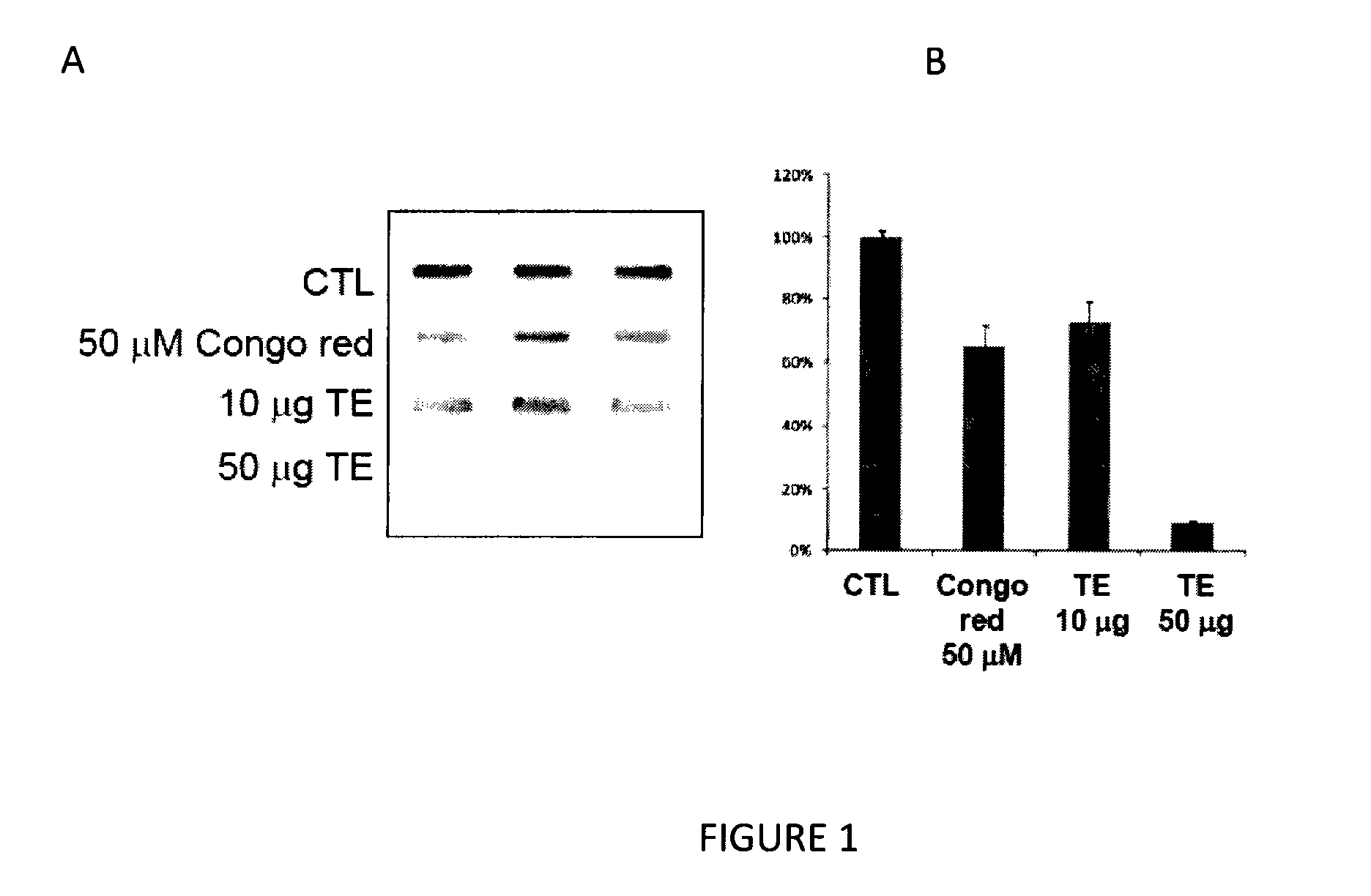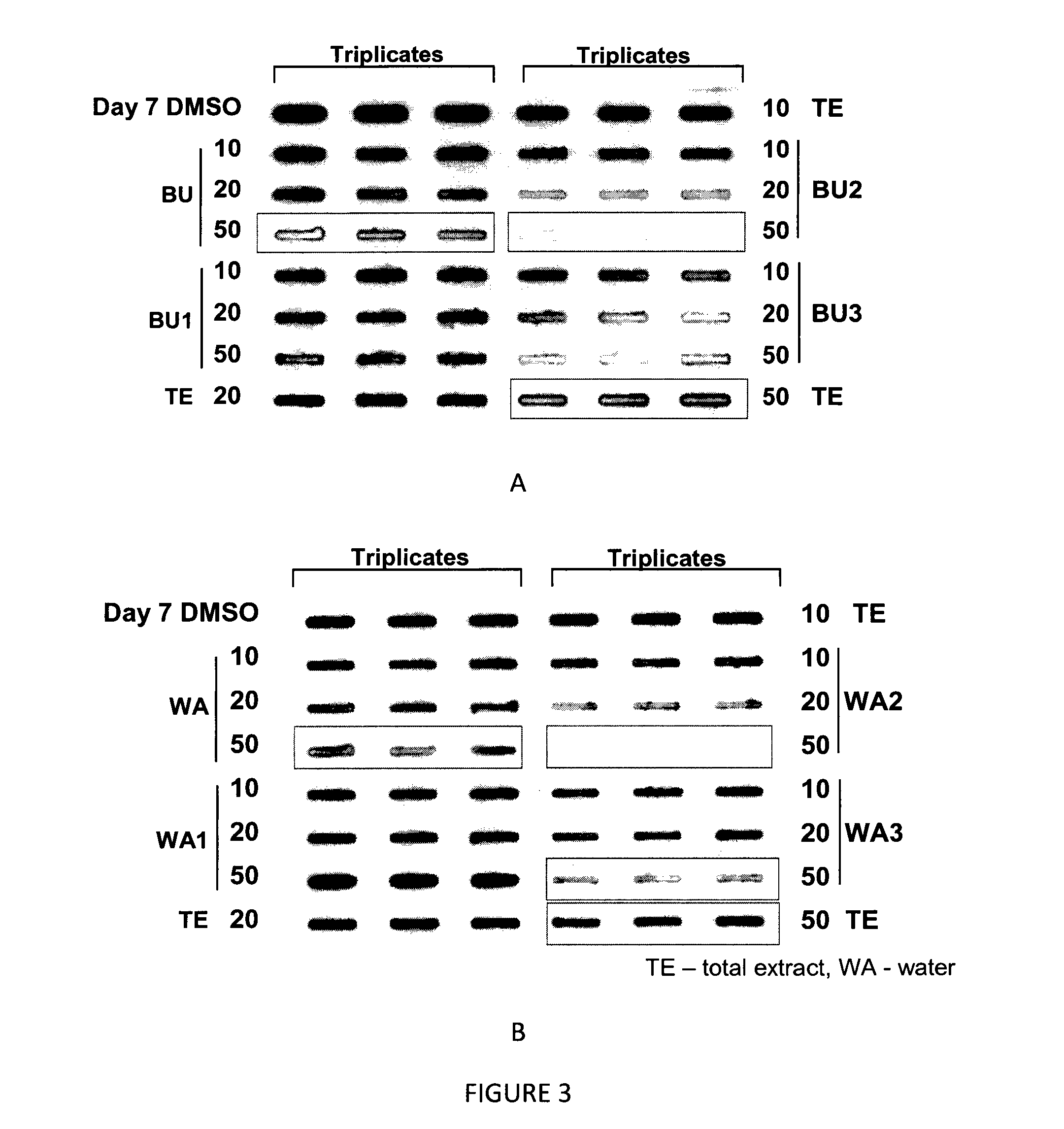Composition for treating neurodegenerative disease or neuropathological condition
a neurodegenerative disease and neuropathological condition technology, applied in the direction of biocide, drug composition, plant/algae/fungi/lichens ingredients, etc., can solve the problems of reducing the effectiveness of drugs, affecting the treatment effect, so as to reduce the aggregation of -synuclein
- Summary
- Abstract
- Description
- Claims
- Application Information
AI Technical Summary
Benefits of technology
Problems solved by technology
Method used
Image
Examples
example 1
[0082]The following example illustrates the use of Alpinia officinarum extract to inhibit α-synuclein aggregation.
[0083]Total extract (TE) of Alpinia officinarum (AO) was prepared as described in Material and Methods. Purified GST-α-synuclein in TBS was then incubated with the extract (10 or 50 μg) for 7 days at room temperature. After incubation, the samples were filtered with a Bio-Dot SF microfiltration apparatus (Bio Rad) according to the manufacturer's instructions. After filtration, the amount of trapped α-synuclein was determined by Western blot analysis. The assay was performed in triplicate, and the results are provided in FIG. 1.
[0084]As seen in FIG. 1, TE strongly inhibits α-synuclein aggregation when compared to vehicle-treated control. Furthermore, the anti-aggregation activity of the total extract (TE) of Alpinia officinarum (AO) is dose-dependent and it is more potent than the well-studied anti-aggregation compound, Congo red (FIG. 1).
example 2
[0085]The following example illustrates the use of a butanol and water fraction of Alpinia officinarum to inhibit α-synuclein aggregation.
[0086]To identify the active anti-aggregation components in AO, the total extract of AO was further fractionated using chloroform (CF), butanol (BU), and water (WA). Each fraction (50 μg) was incubated with α-synuclein (7 μg) recombinant protein for 7 days. The assay was performed in triplicate and repeated at least 2 times. Protein was detected as described in Example 1. The results are provided in FIG. 2.
[0087]As the results show, the active components were found to reside more in the BU fraction and to a lesser extent in the WA fraction (FIG. 2). The CF fraction was found to have no effect on anti-aggregation activity.
example 3
[0088]The following example illustrates the effect that further subfractions of AO extract have on α-synuclein aggregation activities.
[0089]The butanol (BU) and water (WA) fractions of AO from Example 2 were further sub-fractionated into 3 portions using column chromatography eluted with sequential dilutions of ethanol. Each of the subfractions (10-50 μg) was incubated with α-synuclein (7 μg) recombinant protein for 7 days. The assay was performed in triplicate and repeated at least 2 times. Protein was detected as described in Example 1. The results are provided in FIG. 3.
[0090]As the results show, the active components of AO are found in BU2, BU3, WA2 and WA3. Active components found were BU2 and BU3 (butanol sub-fraction 2 & 3), WA2 and WA3 (water sub-fractions 2 & 3). BU2 and WA2 showed better anti-aggregative effect than TE when compared at the same dosages.
PUM
| Property | Measurement | Unit |
|---|---|---|
| solubility | aaaaa | aaaaa |
| solubility | aaaaa | aaaaa |
| solubility | aaaaa | aaaaa |
Abstract
Description
Claims
Application Information
 Login to View More
Login to View More - R&D
- Intellectual Property
- Life Sciences
- Materials
- Tech Scout
- Unparalleled Data Quality
- Higher Quality Content
- 60% Fewer Hallucinations
Browse by: Latest US Patents, China's latest patents, Technical Efficacy Thesaurus, Application Domain, Technology Topic, Popular Technical Reports.
© 2025 PatSnap. All rights reserved.Legal|Privacy policy|Modern Slavery Act Transparency Statement|Sitemap|About US| Contact US: help@patsnap.com



